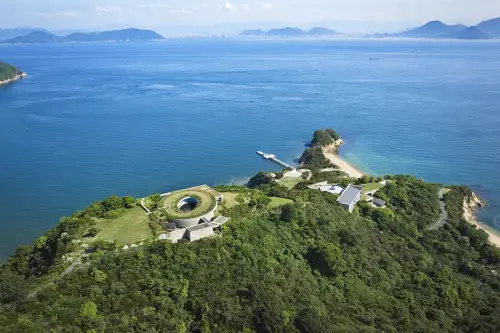Next year, visitors from around the world will flock to Osaka, Japan for the EXPO 2025. The event will focus on designing a better society for the future, and will show off Osaka’s brand new architectural wonder, the Grand Roof (ring). A sustainable design and symbol of the event, this feat of engineering is set to be one of the biggest wooden structures in the world.
Osaka, however, is not the only place to see such groundbreaking construction. A mere hop skip and a jump away from the city center – or a few hours by train or bus for the more practically minded – is an island packed with fantastic offerings for the architecturally inclined.
As the smallest of Japan’s four main islands, Shikoku doesn’t receive as much attention as its neighbors; but to miss out on all this island has to offer would be a mistake. Shikoku is rich in culture and history and is renowned for its natural beauty. It also boasts some of the country’s most stunning architectural gems. While the island has had a long history of isolationism, today Shikoku serves as a beacon in Japan’s quest for sustainable design, featuring buildings that embody the techniques and traditions of the past whilst looking toward the needs of the future.
Step into a gloriously preserved past in Ozu City, Ehime
Across Japan, rural villages and towns are dwindling as the population falls and residents head to bigger cities. This has sadly resulted in a swathe of historic buildings falling into disrepair and obscurity. Thankfully, this is not the case in Ozu. The historical city in Ehime Prefecture is working on a solution to ensure the future preservation of its historic buildings whilst also bringing in tourism.
Of the town’s charms, Diego Cosa Fernandez, Architecture and Culture Research Dep. Director, explains, “Ozu is a town that suffered less alteration during the 20th century than many other Japanese municipalities. Coupled with a rich history as a medieval castle-town, visitors can enjoy multiple layers of history in a very compact area. This is more evident for architecture lovers, since fine examples of military, religious and civil architecture abound, dating from Edo, Meiji, Taisho or early Showa periods.”
In 2017, alarm bells rang when a number of demolitions took place with more looming on the horizon. The town came together with the hope of saving the remaining buildings, collaborating with the Nipponia brand which utilizes the Alberghi Diffusi concept founded in Italy. Within 6 years, 31 houses have been transformed into accommodation or shops, many of which now serve as part of the Nipponia Hotel, a decentralized hotel made up of historically significant buildings scattered around the town.
The purpose is to not only retain and use these culturally significant buildings, but to provide guests with an immersive and luxurious experience; one that would be difficult to find in a more conventional hotel. Nipponia Hotel’s set up encourages guests to interact with the surroundings and locals, with optional activities such as watching traditional cormorant fishing whilst enjoying a river dinner cruise ensuring unique and lasting memories.
Discover a building with a mission in Kamikatsu, Tokushima
Known as the Zero Waste Town, Kamikatsu has received worldwide attention for being the first town in Japan to make a Zero Waste Declaration in 2003 – a declaration it takes very seriously. Whilst many towns, cities, even countries, promise to do better for the environment, Kamikatsu is actually following through on its promise. The crux of this lies in the Kamikatsu Zero Waste Center ‘Why.’ The building, designed by Hiroshi Nakamura, is shaped in the form of a giant question mark, to encourage visitors to think about “why” they consume.
From implementing a 45 category recycling system to educating both locals and visitors, the center is multifunctional with different sections of the building each serving a different purpose. Much of the building is dedicated to the waste station, but there is also a thrift shop, a learning space, a laundry room, and a collaborative laboratory.
The point at the bottom of the question mark, separated from the rest of the building, serves as accommodation in the form of Hotel Why. This hotel goes to show that you don’t need something new and expensive to create a beautiful space. Almost everything within the hotel is recycled and reused, from the ceramic flooring in the bathroom to the denim rugs in the living area. On top of this, each room comes with magnificent views of the forests and lake seen through recycled windows that act as a funky design feature.
Hotel guests are invited to experience the town and discover what is at the root of the locals’ dedication to recycling and are encouraged to re-examine their own relationship with consumerism and waste, something the environment calls on all of us to do.
Witness the vision of an architect come alive in Yusuhara, Kochi
A small, mountainous, rural town in Kochi, is not typically where you would expect to find the work of a world renowned architect. Yet Kuma Kengo, a lauded Japanese architect, chose Yusuhara, a town located on the southern slopes of the Shikoku mountains, to build not one, not two, but six of his designs.
Kuma’s relationship with the town began in the 1980s whilst helping to preserve the town’s post war theater, but it wouldn’t end there. Inspired by the town’s natural setting, its logging history, and traditional architectural techniques, Kuma continued to collaborate with local craftspeople, designing six buildings in total over the span of three decades. They include the Town Office, Machi-no-Eki Yusuhara (Community Market and Hotel), Kumo-no-Ue-no Gallery, Kumo-no-Ue no Hotel, Yusuhara Town Integrated Welfare Facility, and Kumo-no-Ue Library.
“Anyone familiar with Kuma Kengo’s work will recognize his use of natural materials to craft modern spaces that deepen the bond between his buildings, the surrounding landscape, and local communities,” explains Mika, an international resident and inbound media specialist who has called Kochi home for the last few years.
“Personally, I found that the Kumo-no-Ue Library most genuinely and richly embodied its connection to the people who live in Yusuhara. Even in such a small town, I was surprised by the number of people visiting and reading in the library. I really got the sense that this library was designed with people in mind, and seeing so many people, quietly reading in their designated corner or sofa, really reinforced that idea.”
Kuma’s designs have not only created beautiful spaces for the community to thrive within but they have put the town on the map, drawing interest from both domestic and international travelers to Japan.
Explore “the coexistence of nature, architecture, and art” in Naoshima, Kagawa
Just off the coast of Kagawa is Naoshima Island, fondly known as Japan’s Art Island. A part of the stunning Seto Inland Sea, Naoshima became an island reborn when it embarked on a mission to become a cultural and educational island with the help of the Benesse Corporation. Once struggling against a declining population, Naoshima now thrives as a globally recognized destination for art and design enthusiasts.
Home to a number of museums and art attractions, one of the island’s most prolific is the Benesse House designed by Ando Tadao. Bearing in mind its philosophy of “the coexistence of nature, architecture, and art,” the Benesse House seamlessly creates a sense of cohesion between the artwork, many of which are designed specifically for the space, the building, and the environment.
Travel writer-photographer, Todd Fong, remarks, “The architecture enhances the natural beauty of Naoshima and the Seto Inland Sea rather than detract from it by making itself the center of attention. For example, when you are looking out over your balcony or from your seat in the restaurant, the architecture provides a frame for a living image: such as the sun setting over the Inland Sea.”
Fong notes that, “Everything is so minimal, down to the gray color of the concrete walls, you never feel like the architecture is competing for attention with the natural environment. The buildings are mere frames for the real beauty of Setouchi.”
Thanks to the museum’s openness to the elements, as the seasons change so too does Benesse House. If you had previously visited in the spring, you would be greeted by an entirely new experience should you return again in the fall, allowing you to fall in love all over again.
Whilst Shikoku remains one of Japan’s less explored destinations, this means there is so much yet to uncover and explore. Unique and beautiful locations, such as the examples above, give visitors a fascinating insight into the culture and aesthetic of Japan. Combine this with the scenic beauty and tranquility of Shikoku and you have a destination that is well worth the journey.

















